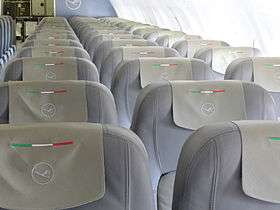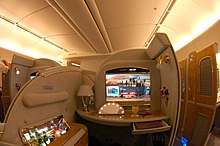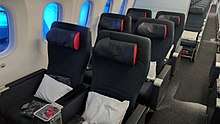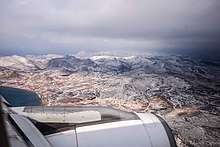Aircraft seating
When flying, your comfort will be determined to a large extent by your assigned seating, especially on large aircraft with several cabin classes.
In general, seating gets more critical the longer the flight gets. An uncomfortable seat can be bearable on a flight shorter than an hour.
Seat assignment

Most airlines assign booked seats before your flight; see Planning your flight.
A few airlines do not assign seats (e.g., Southwest), but do assign you a boarding group based on how early you confirm your flight on-line within 24 hours of the flight.
Especially at low-cost airlines, seat selection might come with a surcharge. Passengers who pay for a no-frills ticket will be assigned to the remaining seats. Seats are then often handed out at a first-come-first-served basis, which makes passengers more likely to show up early for boarding, reducing dwell times for the airline. That is exactly why those airlines implement this system.
As they receive your booking for a specific flight, most airlines will promptly assign you a seat. If so, consult SeatGuru (noted below) and visit the airline web-site soon after. If dissatisfied with the automatic selection, see if you can choose another inter-actively from all available seats on the plane in your cabin class. If you are checking in at the airline's counter with no seat yet assigned, you should ask if a desirable seat is still available.
Cabin classes
The cabin classes vary greatly in comfort, service and ticket price. First and business class tickets have other perks, such as lounge access, higher baggage allowance, fast-track security checkpoints, included premium meals and beverages, higher mileage accrual rates, and more flexible booking opportunities. Passengers are normally not permitted to access the cabins of classes that are higher than what they are ticketed for.

- First Class can usually only be found on the largest aircraft. Not all legacy carriers offer a proper first class product even on long-haul routes. It is always at the front of the aircraft to minimize engine noise, and offers luxurious seating with generous leg-room and well-padded, wide seats. On aircraft configured for long routes, the seats often recline fully to create comfortable single beds. Each may be set within walls providing some privacy. These features, plus the superb meal, drink and services that accompany them, drive the typical cost of tickets to many times that for economy or even business class.
- Although legacy US carriers (Delta, United, American) designate their highest class of service as first class on most domestic flights, first class seating comparable to what is offered on long-haul flights is typically found only on selected transcontinental routes. Other flights with domestic first class seats typically resemble short-haul business class seats in Europe or Asia.

- Some carriers that operate an Airbus A380 such as Emirates and Singapore Airlines offer something that resembles a mini-hotel suite more than a typical 'cradle' first class seat. These are much more spacious than the 'cradle' seats. Each seat can cost tens of thousands of dollars (even if they offer a 'cradle' first class seat for the same route at a fraction of the cost) and depending on the carrier, can either be offered alongside a typical first class seat or in lieu of it.

- Business Class is found toward the front of legacy carriers' aircraft. It comes in two variants: regional and long-haul. Business class is often the highest class of service offered on regional flights. The features described below, plus deluxe meals, drink and other services, drive the typical cost of tickets to several times that for economy class.
- Regional business class seats vary considerably. They can either be proper two-seater blocs with a considerably larger amount of recline (sometimes angled lie-flat) and legroom compared to economy class or make-shift seats which can be designated as (regular/standard) economy class seats on some flights. If a carrier uses the latter variant, the middle seat will be empty and a device may be used to slightly widen the other two seats when the row those seats are in is designated as a business class row.
- Nowadays, long haul business class seats can be converted into beds. This is normally done be using the controls to recline the seat to a full 180 degrees. In addition, newer seats also have walls for some privacy and specialised storage compartments for passenger's other items such as gadgets, smaller bags, shoes. On wide-body aircraft, long haul business class is typically configured 1-2-1 abreast (one outer seat on each side and two in the middle) although some older business class sections are configured 2-2-2 or 2-3-2 abreast.

- Premium Economy offers greater leg-room (perhaps wider seats) than standard economy, with somewhat better meal and entertainment services. Formerly only available on a few airlines, particularly on aircraft intended primarily for long-haul routes, it has now spread to many airlines and even rather short haul routes; no frills airlines might sell seat reservations in the emergency exit row as a "premium" product due to the bigger legroom. The seats recline slightly more than (regular/standard) economy class. On long-haul premium economy class, there are usually no middle seats on the outer bloc which means passengers will be at most one seat away from the aisle. This is usually the highest class on budget airlines. Often, premium economy passengers have separate check-in desks and boarding lanes from (regular/standard) economy passengers but passengers booked on this class typically do not get automatic lounge access.
.jpg)
- (Regular/standard) Economy Class, also known as tourist class or coach, makes up the bulk of aircraft seating.
- In those flavors, seat-width and "pitch" basically determine comfort, though newer designs may have seat cushion and seat back contouring that also help. Pitch means the distance between a fixed point on one seat and that same point on the seat behind it. It basically defines the amount of legroom someone will enjoy or (possibly) suffer.
- In standard economy on full-sized aircraft, pitch can vary from 30-32 inches, and width from 17-18 or more inches. In premium economy, seats may only offer greater pitch, perhaps 35-36 inches; on many flights, that extra legroom comes at substantial cost. On long flights, these variations can be enough to make travel comfort range from acceptable to somewhat miserable, e.g., 17 inches width for the portly can force them into the space of seatmates, or a 30 inch pitch (poor legroom) can cause a person with long legs some pain.
- In regional jets or short-haul propeller aircraft, widths may be under 17", while pitch can be 28 or so inches. However, a few newer regional jets compete nicely with full-size aircraft for space.
SeatGuru and other sites (noted below) can provide seating maps/details/comments (and other information rarely shown on airline web sites) to help you judge whether particular aircraft and seating will be comfortable for the travel you plan.
Other factors
Beyond cabin class, other considerations for comfort/etc. include:

- Window seats, popular with many flyers, as they allow you to look out the window, rest your head against it while sleeping and not be disturbed by other passengers. The major downside is that you may have to climb over a seatmate or two to reach the aisle for any purpose. You may also have slightly less floor space due to the curvature of the plane's hull, and the wall can become somewhat cool.
- Aisle seats, the choice of some road warriors because they make it easy to get out and off the plane, may provide slightly more leg space, and make it easier to get up and stretch your legs. On long flights, though, it's hard to sleep with people walking by, seatmates climbing over you, and the risk of your elbow being hit by a service trolley passing by. Planes usually disembark row-by-row, so a seat further forward will often get you out at your destination quicker than an aisle seat farther back.
- Middle seats tend to combine the disadvantages of both aisle and window seats without the advantages of either, although taller passengers may still be able to see the view from the window.
- Many double-aisle/wide-body aircraft have just two outer seats near the windows, with 3-4 or so between the aisles. These outer seats are desirable for couples and friends who can easily "coordinate" needs to get to the aisle. The middle seats may be useful for families.
On well-equipped (but poorly-designed) aircraft, some seats in each row may have entertainment electronics installed underneath. These intrude on foot room for those seated behind. Poor foot room can be a major annoyance and source of discomfort on long flights. SeatGuru and other site details may help you avoid them.

There are also some special seat rows:
- Exit row seats are next to the emergency exit rows, and have significantly greater legroom than standard seats. You also have easier access to the aisles regardless of whether you are sitting in an exit or the aisle seat. A disadvantage of these seats is that the tray tables are tucked into the armrests on some aircraft and as a result, you can't lift the armrests between seats. This shouldn't be much of a problem when you have occupants beside you, but if there is none you may want to but can't spread out a bit. In addition, many carriers may require all your hand baggage to go in an overhead compartment; there are no seats directly in front of you under which to store items. Passengers in these seats are required to help attendants with the door in an emergency. If you are physically unable to help, if you are deaf or blind, if you are a child or supervising a child, or if you are pregnant, you won't be allowed to sit there . Because of the desirability of exit-row seats, some airlines now charge extra for them, using the name "Economy Plus" or similar. If you're quite tall, you may sometimes get these seats without paying but don't count on it. Ask specifically at check-in and state the reason you want/need one.
- Bulkhead seats are in the first row of each section and thus have no seat reclining into you.
- You may face a wall, and thus will have no seat in front of you to store carry-ons; like exit rows, you'll have to store all your baggage overhead.
- Legroom can be different from other seats...sometimes better but sometimes worse.
- They're often the only seats that can be outfitted with infant bassinets, so most airlines reserve them for families with small children. You may be able to snag one on check-in (some airlines assign them as regular seats without request) or even at the gate, but then you run the risk of sitting next to a baby or infant for your entire flight. They also have the tray table built into the armrest. Portly people can have difficulty folding the table into position for use.
- Some bulkhead seats have a bulkhead immediately behind them. That often means the seat back cannot be reclined at all...not a problem if you always sit upright.
Those wishing to avoid airsickness should choose seats over the wings of the aircraft, near the center of gravity. Occupants of those seats tend to feel less turbulence than passengers in seats toward the rear.
Passengers who want a bit more elbow room (even in economy class) might consider the last row of window seats on the plane. Due to the curvature of the plane, window seat passengers near the end of the plane may have a tad more elbow room on the window side...sometimes enough to fit a medium-sized totebag. However, per some notes in SeatGuru/etc.,:
- "Window seats" in the back row may in fact offer nothing more than a blank wall.
- If close to the lavatories or a galley, you may be bothered by waiting passengers or odors.
In addition to obvious the choice between window seats (good views), aisle seats (more freedom to move) and middle seats, there are other sometimes subtle considerations for choosing a slightly more comfortable economy class seat.
How close you sit to the front or back end of the plane is a mixed bag of benefits and drawbacks. In most jet aircraft, seats in the back experience more cabin noise; the difference can be significant enough to cause discomfort, and it's one of the reasons why first class is always located in the front. In wide-body aircraft, rear economy window seats will provide you with a better view than in the front of the economy section, where the view is obstructed by the wings. The effects of turbulence are weakest near the leading edge of the wing, in the middle of the aircraft. Finally, US National Transportation Safety Board data from accidents in which some passengers survived and others did not, indicate that seats at the rear of the plane are statistically safer.
Airplanes also have "ordinary" seats that are less or more desirable for some reason:
- Seats at the tail end of the plane often have no middle seats, which gives you more room to spread out
- Seats just before the exit row and at the end of a section may not recline
- Seats next to the toilets may include odors and have lots of people queuing outside.
- Seats next to the galleys may be noisy especially when flight attendants prepare and roll-out the meals; based on the menu, foods being heated may generate aromas or odors; and "kitchen" lights are always on.
It may be possible to simulate some of the comfort of first class by claiming a row of unoccupied seats, and raising the armrests to form a makeshift bed. Watch for such rows as the last passengers are taking seats. The flight attendants are also aware of these rows, and may use them to relocate people. Your quick action may preserve your "bed". If you want to sleep, fasten your seatbelt over any "cover" (e.g., coat/jacket, blanket) so your belt visible; otherwise, you'll be pestered by the flight attendants should the "fasten seatbelt" sign turn on mid-flight.
With all these considerations for seating, to figure out the good and not so good, consult online sites that provide detailed maps for in-service aircraft and can help when choosing the best seat, e.g.,:
If you know what type of aircraft you are traveling on, you can look up the seat map on these sites. SeatExpert also offers a unique feature that allows you to find a seat map by entering your flight information (airline, flight number, date of departure). SeatGuru also helps to find out what aircraft type you'll be flying .
Sometimes aircraft scheduled to fly on a certain day for a certain flight may be substituted for another aircraft at the last minute. Therefore it is a good idea to take a look at all possible aircraft and their respective configurations to find out the number of your preferred seat. Furthermore, an airline may have a certain kind of aircraft with different configurations. For example, the front row in one of Airline X's 777s may be row 1 but in another kind of 777 of Airline X it could be row 11 even if the front row of both 777s are of the same service class. It is also worth knowing if the an airline's aircraft is 2nd hand or leased from another airline as the seat design may have significant differences from in-house aircraft.
As you take your seat, quickly examine its fixtures; if there' something wrong, e.g., the electronics don't work. Also if you are sitting next to someone who takes more than their share of the seat, or who may be ill, then ask for help from a flight attendant. Unless the flight is full (frequently), they can re-seat you if they know about the problem early enough.
Special considerations also often apply to unaccompanied minors, who are typically seated at the front section so flight attendants can pay close attention to them. Some airlines, most notably British Airways, Qantas and Air New Zealand do not permit male passengers to be seated next to unaccompanied minors. If you are a male passenger who selected or was assigned a seat next to an unaccompanied minor, you will be made to swap seats with a female passenger.
Left and right
The plane is above the clouds for most of the flights, and since the horizon is below the plane, it is in sunlight from dusk to dawn.
As both the light and heat might be disturbing, the side on the shade is more comfortable. Calculating the sun's position relative to the plane is an exercise in geometry. In the northern hemisphere, the left side is in the shade when flying east, and the right is in the shade when flying west. The opposite goes for the southern hemisphere.
Planes usually circulate counterclockwise around airports. Therefore, passengers on the left side might see more of the ground, and feel less discomfort from the banking.
Right-handed people might prefer the left side (or the right seats of the middle row) to interact with the aisle. The opposite goes for left-handed people.
At some airports the usual approach or takeoff route leads over an area that is much more interesting to look at on one side than the other. Wikivoyage guides will mention this where it is particularly notable.